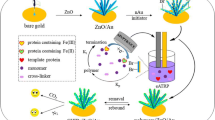Abstract
Based on the strong penetration capacity of near infrared lights (NIRs) and different absorption of oxyhemoglobin and deoxyhemoglobin in NIRs region, a novel noninvasive method, with the aid of an airproof-equilibrium apparatus, was developed to determine the oxygen binding-releasing capacity, including oxygen dissociation curve (ODC) and P50, of the hemoglobin-loaded polymeric nanoparticles (HbP) in this study. The measured ODC of the PLA-PEG HbP was very close to that of the native hemoglobin, and the corresponding P50 (26.1 mmHg) was also near to the native precursor protein (27.3 mmHg), indicative of the validity of the method proposed. To further verify the method proposed, the oxygen binding-releasing capacity of the HbPs prepared by PCL, PCL-PEG, PLA were also investigated with human blood as control. These results indicated that the method developed here enabled accurate and noninvasive determination of the oxygen binding-releasing capacity of the biodegradable polymeric oxygen carriers.




Similar content being viewed by others
References
C. Chauvierre, M.C. Marden, C. Vauthier, D. Labarre, P. Couvreur, L. Lecler, Biomaterials 25, 3081 (2004). doi:10.1016/j.biomaterials.2003.09.097
S.L. Li, J. Nickels, A.F. Palmer, Biomaterials 26, 3759 (2005). doi:10.1016/j.biomaterials.2004.09.015
V. Budhiraja, J.D. Hellums, Microvasc. Res. 64, 220 (2002). doi:10.1006/mvre.2002.2418
T.M.S. Chang, Trends Biochem. Sci. 17, 61 (1999)
T.M.S. Chang, J. Intern. Med. 253, 527 (2003). doi:10.1046/j.1365-2796.2003.01151.x
O. Siggaard-Antiersan, N. Wimberley, Scand. J. Clin. Lab. Invest. 48, 7 (1988). doi:10.3109/00365518809086606
P.S. Addison, J.N. Watson, Med. Eng. Phys. 27, 245 (2005). doi:10.1016/j.medengphy.2004.10.002
N.A. Rosen, W.E. Charash, E.F. Hirsch, J. Surg. Res. 106, 282 (2002). doi:10.1006/jsre.2002.6377
J. Zhao, C.S. Liu, Y. Yuan, X.Y. Tao, X.Q. Shan, Y. Sheng, F. Wu, Biomaterials 28, 1414 (2007). doi:10.1016/j.biomaterials.2006.10.012
X.L. Zhang, C.S. Liu, Y. Yuan, S. Zhang, X.Q. Shan, Y. Sheng, F. Xu, J. Mater. Sci. Mater. Med. 19, 2463 (2008). doi:10.1007/s10856-007-3358-1
B. Giardina, G. Amiconi, Meth. Enzymol. 76, 417 (1981). doi:10.1016/0076-6879(81)76133-0
H.E. Julie, A.F. Palmer, Biotechnol. Prog. 20, 1543 (2004). doi:10.1021/bp049872l
F. Moraga, C. Monge, R. Riquelme, A.J. Llanos, Comp. Biochem. Physiol. 115, 111 (1996). doi:10.1016/0300-9629(96)00016-3
F.T. Meng, G.H. Ma, Y.D. Liu, W. Qiu, Z.G. Su, Colloid. Surf. B. 33, 177 (2004). doi:10.1016/j.colsurfb.2003.10.003
E.K. Park, S.B. Lee, Y.M. Lee, Biomaterials 26, 1053 (2005). doi:10.1016/j.biomaterials.2004.04.008
C.Y. Zheng, G.H. Ma, Z.G. Su, Process. Biochem. 42, 303 (2007). doi:10.1016/j.procbio.2006.08.011
W.G. Zijlstra, A. Buursma, Comp. Biochem. Physiol. 118(B), 743 (1997)
R. Gatto, W. Hoffman, M. Mueller, A. Flores, V.N. Tibor, F.T. Charbel, J. Neurosci. Method. 157, 274 (2006). doi:10.1016/j.jneumeth.2006.04.013
X.H. Li, Y.H. Zhang, R.H. Yan, W.X. Jia, M.L. Yuan, X.M. Deng, Z.T. Huang, J. Control. Release 68, 41 (2000). doi:10.1016/S0168-3659(00)00235-2
Acknowledgement
The authors appreciate the financial support from the National High Technology Research and Development Program of China (863 Program) (No. 2004AA-302050) and from Shanghai Nanotechnology Special Foundation (No. 0452nm022).
Author information
Authors and Affiliations
Corresponding author
Rights and permissions
About this article
Cite this article
Zhang, X., Liu, C., Yuan, Y. et al. A noninvasive method for measuring the oxygen binding-releasing capacity of hemoglobin-loaded polymeric nanoparticles as oxygen carrier. J Mater Sci: Mater Med 20, 1025–1030 (2009). https://doi.org/10.1007/s10856-008-3676-y
Received:
Accepted:
Published:
Issue Date:
DOI: https://doi.org/10.1007/s10856-008-3676-y




